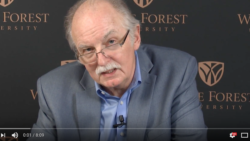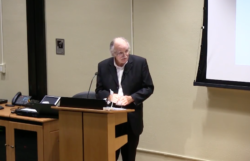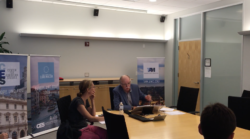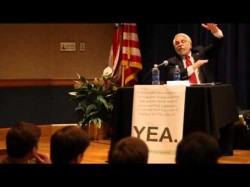The Dangers of Obama’s Centrism
Wednesday’s London Guardian newspaper carried a full report under the banner heading “Barack Obama battles left and right for debt ceiling agreement,” documenting the manner in which he was playing the role of “mediator in direct talks to prevent government bills going unpaid, interest rates soaring and US stocks plummeting.”[1] The paper then briefed its UK audience on the unfolding political drama in Washington, the detail of which is well known to any political junkie based here in the United States. And buried deep in the article was this comment from Ron Haskins: “the Democratic party on average is further left, and the Republican party on average further right, so they are trying to cut a deal between folks who are more driven by their ideologies and principles.” The Guardian, that is, treated its UK liberal readership to the standard “plague on both their houses” interpretation of what is going on in Washington DC right now – the kind of interpretation David Brooks deploys too[2] – the “ it is all so much more complicated than either pure free-marketeers or simple-minded Keynesians seem to grasp” argument. In the hands of either Hoskins or Brooks, The Guardian’s interpretation is one designed to make us grateful for the courage and foresight of a centrist political leader who is willing to demand the surrender of sacred cows on both sides of the aisle. It suggests that political division is the main problem in play here, and that rising above politics is its only solution.
The “plague on both their houses” thesis is such an appealing narrative, particularly to hard-pressed Americans struggling to balance their own budgets, and already alienated from Washington by the regularly-reported depth of partisanship currently there. But as Eugene Robinson documented so clearly in The Washington Post on July 11, the plague thesis is also an entirely misleading narrative;[3] and for progressives at least, a politically dangerous way of describing what is going on, and what is needed. So let us try another narrative instead, another take on what is going on and what is needed. This one, built around these three observations of the dangers of centrism in the midst of crisis:
l. No matter how often triangulation is advocated, it always the case that the center is only stable politically if the two forces between which centrist politicians mediate are similarly fixed. But that is not the situation in Washington DC right now. Liberal positions within the Democratic Party are much as they have ever been: solid in defense of Social Security as a pension system fully-funded by those who eventually receive it, and solid in defense of health care for the old and poor. Those are old and well-established positions, of no great radicalism. What makes them appear so radical in the present political context is the right-wing gravitational pull of the Tea Party Movement on the agenda and thinking of the entire Republican Party. The danger of playing centrist politics in the face of the Tea Party’s “great moving right show” is that the White House is suddenly obliged to tolerate (indeed to advocate) the erosion at the margin of what was once sacrosanct between both parties (and certainly was sacrosanct across the entire Democratic Party) – namely Medicare/Medicaid and Social Security (the former third rail of American politics). The already hard-pressed living standards of the old and the poor suddenly become things to trade away behind a rhetoric of shared sacrifice, even though there is no similarity in the impact on the relevant groups of a cut in Medicaid and a marginal cut in the wealth of the rich. Which leaves open at least one question, rarely posed by the national media – who is really calling the shots in Washington D.C. these days, the intransigent right or the accommodating center? And possibly another question too – will those who campaigned so enthusiastically for Obama in 2008 do so again in any numbers in 2012?
2. There is a lesson here for the next general election: that the center will only hold electorally if the accommodations offered by the White House to win temporary political settlements will actually produce public policy that works. But in this case they won’t. The odds are that any compromise reached will make short-term economic conditions worse. Those conditions would improve if what the Republicans claim is true: namely that unemployment now is caused by lack of business confidence, rooted in the size of the federal deficit; and that pruning government programs will free up the space for a rapid expansion of private sector employment. But the evidence is overwhelming that any lack of confidence linked to the debt ceiling is entirely the product of the Republican Party’s decision to use the raising of the debt ceiling as a bargaining chip in their campaign for welfare retrenchment and the erosion of minority rights (especially gay and abortion rights).[4] The evidence is overwhelming that what is actually holding back private sector employment growth is a lack of demand for private sector output, a lack of demand rooted in stagnant/falling wages, home foreclosures and massive unemployment.[5] And the evidence is overwhelming that cutting public spending actually creates more unemployment – especially unemployment at the state level as federal stimulus money runs out and tax revenues remain depleted by low rates of economic growth.[6] By upping the anti- in the way he has done – pushing the Republicans to accept large-scale deficit reduction through big spending cuts and modest tax hikes – the President has reinforced in the public mind the underlying assertion of the entire Republican case: namely that our economic problems are primarily caused by excessive government spending and taxation. If that perception persists, November 2012 will see a rout of the Democratic Left.
3. The center will only succeed economically if it pulls the political debate back onto saner ground: saner ground on the immediate causes of unemployment, and saner ground on the long-term causes of U.S. economic underperformance. On the former, the White House should be insisting on (and actively campaigning for) a new stimulus package.[7] It should be making the case again that the current debt problem is the product of unfunded spending and tax policies inherited from the Bush years, and of the recession caused by lack of tight financial regulation – and then pushing for direct federal aid to hard-pressed state budgets (to protect education and Medicaid) paid for by an aggressive program of closing tax loopholes and ending tax cuts for the rich. The White House should also be arguing, to the exclusion of any concessions on the “burden” of public spending, that the long-term solution to the debt crisis is not just a matter of establishing some control over rising health care costs, vital as this is. It is also a matter of generating sustained economic growth through the recreation of high-paying jobs in a revitalized U.S. civil manufacturing sector. Free-market economics that privilege tax cuts and deregulation will never produce that. Managed-market economics organized around an active industrial policy might just get us there – though getting out of any hole becomes progressively more difficult the deeper the hole is and the longer we are in it. Time is not our friend on this matter, and the White House needs to realize that – and begin to try.
As the respected financial journalist Martin Wolf wrote in Thursday’s Financial Times, “the view of Republican hawks in the US…that the crisis has fiscal roots alone is wrong,” and because it is, “the US may be on the verge of making among the biggest and least necessary financial mistakes in world history.”[8] So with Republican intransigence on the tax side of the current budget equation now losing the Party support – including support even from major business interests – this is not the time to offer yet more concessions to a bankrupt philosophy. Nor is it the time to play politics with the whole notion of federal debt – offering even bigger cuts on terms Republicans can’t accept, just to make sure Democratic centrists look reasonable by comparison.[9] All that that kind of politicking does is further entrench a political climate that stigmatizes public spending and makes a bogey of federal regulation. Obama might win the odd Washington battle playing that game; but without his solid advocacy of public services and federal regulation, those of us fighting for a fairer America will inevitably lose the war.
These arguments are developed more fully in Chapter 6 of Making the Progressive Case, New York, Continuum Books, 2011
[2] David Brooks, “The Magic Lever,” The New York Times, July 11, 2011: available at http://www.nytimes.com/2011/07/12/opinion/12brooks.html
[3] Eugene Robinson, “Don’t blame ‘both sides’ for debt impasse,” The Washington Post, July 11, 2011: available at http://www.washingtonpost.com/opinions/dont-blame-both-sides-for-debt-impasse/2011/07/11/gIQA0XDg9H_story.html
[4] On this, see https://www.davidcoates.net/2011/06/15/not-working-in-america-people-and-public-policy-2/
[6] On this, see http://economix.blogs.nytimes.com/2011/07/08/the-cost-of-austerity/. “State and local governments shed 100,000 workers between January and May of this year, and have cut a total of 350,000 workers since the start of 2010, according to the federal Labor Department.” (The Wall Street Journal, July 7, 2011, p. A6)
[7] The case is put by Laura Tyson, “Only more stimulus can fix a jobless recovery,” The Financial Times, July 8, 2011: available by subscription at http://blogs.ft.com/the-a-list/2011/07/07/only-further-stimulus-can-tackle-america%E2%80%99s-jobless-wage-less-recovery/?Authorised=false#axzz1S0OjbMVo
[8] Martin Wolf, “From Italy to the US utopia vs reality,” The Financial Times, July 13, 2011: available by subscription at http://www.ft.com/intl/cms/s/0/979c10d8-acb8-11e0-a2f3-00144feabdc0.html#axzz1S5vEQL2N
[9] For this argument more fully, see http://www.alternet.org/economy/151561/is_obama_on_the_brink_of_cutting_social_security_the_dangerous_game_over_the_debt_ceiling/
David Coates holds the Worrell Chair in Anglo-American Studies at Wake Forest University. He is the author of Answering Back: Liberal Responses to Conservative Arguments, New York: Continuum Books, 2010.
He writes here in a personal capacity.






Patricia Dixon says:
For those of us who voted for President Obama in 2008, it is getting harder to justify a second vote for him in this next election. His centrist policies have shown a departure from his promises to tax the wealthiest Americans, close loopholes for corporations and protect what you label as the “old well established positions” of the Democrats. So what choices do we have? I think we need a third party who can hold both parties to the task of true bipartisan negotiations that put Americans first,instead of corporations first.
When impasse in Washington leaves us holding the bag, then we need to reinvent the methodology of how we create a more meaningful dialog among politicians and how we elect them.
The apathy of Americans to engage in politics is at the heart of the problem, when we decide as a people that we need to be “actively vigilant” of our political system and “get involved in it at every level in the society”, then we might have a chance at changing the rules of engagement. We must commit to a better way of electing our representatives, and take the money out of the equation.